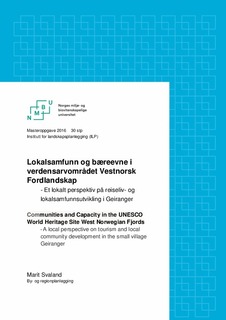| dc.contributor.advisor | Stokke, Knut Bjørn | |
| dc.contributor.author | Svaland, Marit | |
| dc.coverage.spatial | Norway, Geiranger | nb_NO |
| dc.date.accessioned | 2017-04-05T11:45:28Z | |
| dc.date.available | 2017-04-05T11:45:28Z | |
| dc.date.issued | 2016 | |
| dc.identifier.uri | http://hdl.handle.net/11250/2436868 | |
| dc.description.abstract | Dette studiet tar utgangspunkt i tettstedet Geiranger som er innlemmet i verdensarvområdet Vestnorsk Fjordlandskap. UNESCO har i sin konvensjon satt et krav om å ivareta de vernede natur- og kulturverdier også for fremtiden. Gjennom forvaltningsplanen til Vestnorsk Fjordlandskap imøtekommes dette kravet gjennom mål om å beskytte natur- og kulturverdiene samtidig som man møter behovet til lokalsamfunnet gjennom prinsippet om bærekraft. Hvert år besøker 700 000 turister Geiranger med sine 250 innbyggere og man får et møte mellom reiseliv og lokalsamfunn. Jeg ønsker å belyse dette møte fra et lokalt perspektiv. Gjennom gjeldende planverk for Geiranger og gjennom dybdeintervju med et utvalg fra lokalbefolkningen (8 informanter) ønsker jeg å belyses lokalsamfunnet i møte med reiselivet. Gjennom planene belyses reisemålsutvikling og lokalsamfunnsutvikling og hvordan dette kombineres gjennom planleggingen. Intervjuene belyser holdninger, ønsker og tanker rundt reiselivet som del av lokalsamfunnet. Dette lokalperspektivet er viktig for å frembringe kunnskap som kan bidra til koordinert og helhetlig samfunnsplanlegging og forvaltning. Funnene i studiet diskuteres i lys av teori og tidligere forskning. Reisemål- og lokalsamfunnsutvikling, plan som prosess og produkt, bærekraftig reiseliv, bytteteorien og tilknytting til lokalsamfunnet utgjør det teoretiske rammeverket i dette studiet.
Planverket brukt i dette studiet viser at lokalsamfunn og reiseliv er representert i planene, men at det varierer hvor mye fokus som tillegges de to forskjellige sidene. Informantene i studiet viste til forskjellige ulemper og fordeler som la grunnlag for informantenes holdninger til reiselivet og tilhørende utvikling i Geiranger. Også tilhørighetsfølelse la grunnlag for holdningene informantene hadde til reiselivet. Generelt var det en positiv holdning til reiselivet og et ønske om å ha reiselivet som del av lokalsamfunnet i Geiranger, men det var uenigheter rundt forvaltningen og omfanget av turistene. Strengere regulering, bedre tilrettelegging og forvaltning ble etterspurt av informantene, som hadde en negativ holdning til dagens reiselivssituasjon i geiranger. Informantenes syn på hva slags trusler reiselivet innebar for lokalsamfunnet knyttet seg stort sett til cruiseturiseme. Forståelse og respekt av og rundt verdiskapingspotensialet som oppstår som følge av reiselivet og medvirkning i planleggingen ser ut til å være nøkkelen for å skape synergier mellom reiseliv og lokalsamfunn i Gerianger. Slik vil man også kombinere god lokalutvikling med god reisemålsutvikling og samtidig gi et bærekraftig grunnlag. | nb_NO |
| dc.description.abstract | This thesis is a case study based on Geiranger which is incorporated into the world heritage area Vestnorsk Fjordlandskap. UNESCO have in their convention set a requirement to safeguard the protected natural and cultural values for the future generation. Through the Vestnorske Fjordlandskap's management plan this requirement is considered trough goals to protect natural and cultural values while also meeting the needs of local community trough the principle of sustainability. Every year, 700,000 tourists visits Geiranger with its 250 inhabitants and one gets a meeting between tourism and communities. I want to illustrate this meeting from a local perspective in this thesis. Through current plans reguarding Geiranger and through in-depth interviews with a sample of locals (8 informants) i want to highlight local community facing tourism. Destination development and local community development and how these are combined trough planning are highlighted in this thesis. Through the interviews we get to know what kind of attitudes, desires and thoughts the informants has regarding tourism as part of their community. These kinds of local perspective are important to produce knowledge that can contribute to coordinated and comprehensive community planning and management. The findings of the study are discussed in light of theory and previous research such as; destinations and communities' development, planning as process and product, sustainable tourism, social exchange theory and linking to local communities. This theory and research constitutes the theoretical framework of this study.
The plans used in this study shows that local communities and tourism are represented in the plans, but that the amount of focus on the two different sides varies. The informants showed the various advantages and disadvantages which laid the basis for the informants' attitudes towards tourism and related development in Geiranger. Also the informants feeling of belonging laid the basis for attitudes towards tourism. In general it was a positive attitude towards tourism and a desire to have tourism as part of their community in Geiranger, but there were disagreements about the management and the scope of tourism. Stricter regulation, better organization and management was requested by the informants who had a negative attitude to the current tourism situation in Geiranger. Views on what kind of threats tourism meant for the community related largely to cruiseturism. Understanding and respect of, and around, potential for value creation arising out of tourism and local participation in planning seems to be the key to creating synergies between tourism and communities in Geirianger. This wil also combine good local development with good tourism/destination development and at the same time give it a sustainable basis. | nb_NO |
| dc.language.iso | nob | nb_NO |
| dc.publisher | Norwegian University of Life Sciences, Ås | nb_NO |
| dc.rights | Attribution-NonCommercial-NoDerivatives 4.0 Internasjonal | * |
| dc.rights.uri | http://creativecommons.org/licenses/by-nc-nd/4.0/deed.no | * |
| dc.subject | Lokalsamfunn | nb_NO |
| dc.subject | Reiseliv | nb_NO |
| dc.subject | Bærekraftig turisme | nb_NO |
| dc.title | Lokalsamfunn og bæreevne i verdensarvområdet Vestnorsk Fjordlandskap : et lokalt perspektiv på reiseliv- og lokalsamfunnsutvikling i Geiranger | nb_NO |
| dc.title.alternative | Communities and capacity in the UNESCO world heritage site West Norwegian Fjords : a local perspective on tourism and local community development in the small village Geiranger | nb_NO |
| dc.type | Master thesis | nb_NO |
| dc.subject.nsi | VDP::Samfunnsvitenskap: 200::Samfunnsgeografi: 290 | nb_NO |
| dc.source.pagenumber | 80 | nb_NO |
| dc.description.localcode | M-BYREG | nb_NO |

